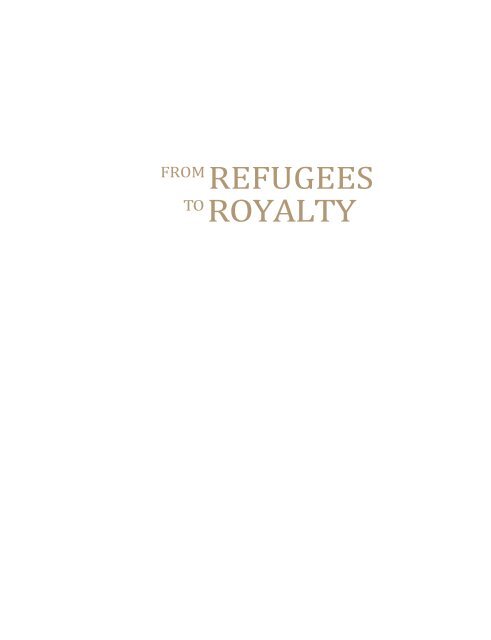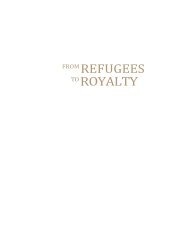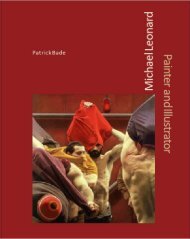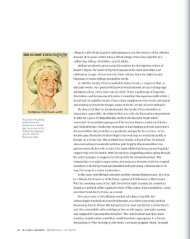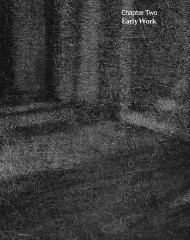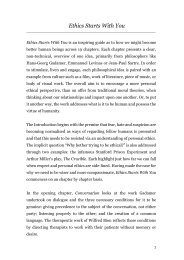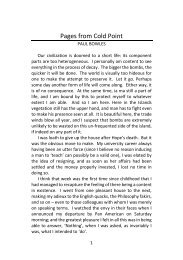You also want an ePaper? Increase the reach of your titles
YUMPU automatically turns print PDFs into web optimized ePapers that Google loves.
FROM<br />
REFUGEES<br />
TO<br />
ROYALTY
FROM REFUGEES<br />
TO<br />
ROYALTY<br />
The Remarkable S<strong>to</strong>ry of the Messel Family of Nymans<br />
JOHN HIL A RY<br />
PETER OWEN<br />
LONDON AND CHICAGO
Peter Owen Publishers<br />
Conway Hall, 25 Red Lion Square<br />
London wc1r 4rl<br />
Peter Owen books are distributed in the usa<br />
and Canada by Independent Publishers Group/<br />
Trafalgar Square<br />
814 North Franklin Street, Chicago, il 60610, usa<br />
Copyright © John Hilary 2021<br />
All Rights Reserved<br />
No part of this publication may be reproduced<br />
in any form or by any means without the written<br />
permission of the publishers.<br />
The moral rights of the author are hereby<br />
asserted in accordance with the Copyright<br />
Designs and Patents Act 1988.<br />
isbn 978‐0‐7206‐2106‐8<br />
A catalogue record for this book is available<br />
from the British Library.<br />
cover and book design<br />
Graphicacy<br />
printed by<br />
Printworks Global Ltd, London & Hong Kong
For my mother
Contents<br />
preface 9<br />
1 The Village of Messel 13<br />
2 Privileged Jews 21<br />
3 Founding a Dynasty 29<br />
4 Architect <strong>to</strong> the Kaiser 35<br />
5 New Life in London 47<br />
6 Tyburnia 55<br />
7 Cultural Integration 63<br />
8 ‘Clear Out the Germans’ 73<br />
9 Nymans 83<br />
10 House and Garden 91<br />
11 For King and Country 101<br />
12 Making His<strong>to</strong>ry 111<br />
13 The Triumph of Hope 121<br />
14 Serious Collecting 133<br />
15 Preserving the Past 143<br />
16 Bright Young Things 151<br />
17 Fame and Fortune 165<br />
18 Cinema and Socialism 181<br />
19 A Pacifist at War 191<br />
20 Royal Wedding 203<br />
21 Disability Campaigner 217<br />
epilogue 227<br />
acknowledgements 231<br />
notes 234<br />
select bibliography 248<br />
picture credits 251<br />
index 252
8<br />
The entrance in<strong>to</strong> the<br />
hallway at Nymans
Preface<br />
‘I wish you could see Nymans – you would be in ecstasies. The house and park and<br />
woods are lovely. The house is huge, about 25 bedrooms and dressing‐rooms and<br />
all furnished exquisitely with a scrupulous denial of anything verging on display<br />
or luxury.’ – Nonie Messel writing <strong>to</strong> her mother on her first visit <strong>to</strong> Nymans,<br />
Christmas 1903<br />
he West Sussex estate of Nymans has long been one of the National Trust’s<br />
most popular properties. Today, Nymans attracts almost 400,000 visi<strong>to</strong>rs every<br />
year, many returning again and again <strong>to</strong> catch the changing seasons in what<br />
the actress Penelope Keith called its ‘beautiful, beautiful garden’. 1 Yet there are a<br />
host of reasons <strong>to</strong> come <strong>to</strong> Nymans. Sarah Clelland, on her mission <strong>to</strong> visit every<br />
National Trust property in the land, captured it perfectly: ‘If a heritage‐loving<br />
alien arrived on Earth and wanted <strong>to</strong> be shown one property that sums up the<br />
National Trust, I’d take it <strong>to</strong> Nymans. It has everything: extensive gardens, a<br />
picturesque ruin, and a mock‐medieval house that you can go inside and see where<br />
an Edwardian Englishwoman lived.’ 2<br />
But who was this Edwardian Englishwoman, and what was she doing living<br />
in a mock‐fifteenth‐century manor house? What led the founder of the garden, a<br />
successful German‐Jewish s<strong>to</strong>ckbroker, <strong>to</strong> buy a rural Sussex estate in the first<br />
place, let alone turn it in<strong>to</strong> one of the horticultural wonders of southern England?<br />
How did the second generation transform themselves in<strong>to</strong> landed gentry and<br />
marry one of their daughters <strong>to</strong> an earl? And how did the Messels, expelled from<br />
their earliest home in Germany by an edict of the British Royal Family, end up<br />
marrying in<strong>to</strong> that same Royal Family two hundred years later?<br />
This book is a s<strong>to</strong>ry of achievement. It tells of a family of outsiders who<br />
triumphed over social exclusion across eight generations, during some of the<br />
darkest days in modern his<strong>to</strong>ry. The journey is fascinating in what it reveals about<br />
the communities which the Messel family made their own. What was it like <strong>to</strong><br />
be Jewish in Germany a hundred years before the Nazis? How did ‘Court Jews’<br />
9
10 from refugees <strong>to</strong> royalty<br />
differ from their less privileged co‐religionists? What was life in London like for<br />
German Jews in the Edwardian era? Ludwig Messel was reputedly the richest man<br />
on the London S<strong>to</strong>ck Exchange, but this did not help him when Germans living<br />
in Britain were engulfed in a wave of xenophobic violence in the opening years of<br />
the First World War.<br />
The s<strong>to</strong>ry of the Messel family is a remarkable one, not just for the journey<br />
which brought them <strong>to</strong> England but for the extraordinary contribution they made<br />
across so many creative disciplines. Each generation has produced pioneers in<br />
their chosen fields, whether architecture or industry, theatre or cinema, fashion<br />
or pho<strong>to</strong>graphy, design, horticulture or the decorative arts. The personal<br />
collections the Messels built up for their private pleasure now grace the nation’s<br />
galleries, while the houses in which they lived are open for public education and<br />
enjoyment. Several of the specialist plants grown in gardens around Britain were<br />
first cultivated at Nymans, and the most famous among them bear the names of<br />
individual members of the Messel family as a testament <strong>to</strong> their success.<br />
Alongside this rich record, there is a more sombre side <strong>to</strong> the family his<strong>to</strong>ry.<br />
The male members of the family, in particular, suffered from serious bouts of<br />
mental illness over at least three generations, at a time when there was limited<br />
treatment available <strong>to</strong> mitigate the impact of the attacks. In its mildest form, this<br />
melancholia – as it was then known – manifested itself in appalling outbursts<br />
of ill temper. At its most damaging it led <strong>to</strong> severe depression and at least one<br />
suicide. Relations within the family could also be strained <strong>to</strong> breaking point<br />
when personal interests were given precedence over shared needs. Even the royal<br />
marriage, the Messel family’s breakthrough in<strong>to</strong> the highest stratum of British<br />
society, collapsed under the weight of self‐indulgence.<br />
Whenever I am at Nymans I pay a special visit <strong>to</strong> the statuette in the Forecourt<br />
Garden dedicated <strong>to</strong> the memory of my grandmother Phoebe Messel and her<br />
brother Rudolph. Both died before I was born, but I was brought up on the s<strong>to</strong>ries<br />
of their deep devotion <strong>to</strong> one another and the magical world they created for my<br />
mother and her siblings when they were growing up. I was <strong>to</strong>ld the basic outlines<br />
of the family his<strong>to</strong>ry, but no one was able <strong>to</strong> explain <strong>to</strong> me why the Messels<br />
first came <strong>to</strong> England or what their lives had been like in Germany before they<br />
migrated. I read the brief backgrounds in books on the more famous members of<br />
the Messel family, but even the best were hazy on the details. The true s<strong>to</strong>ry was<br />
clearly waiting <strong>to</strong> be uncovered.<br />
My search for answers <strong>to</strong>ok me <strong>to</strong> the German market <strong>to</strong>wn of Dieburg,<br />
forty minutes’ train ride south of Frankfurt. I knew that the earliest Jewish<br />
inhabitants of the village of Messel were buried in Dieburg’s Jewish cemetery<br />
and that my ances<strong>to</strong>rs were among them. The section of the cemetery nearest<br />
the entrance contains the last graves of the 1920s and 1930s: severe rows of dark
| preface 11<br />
granite obelisks with Hebrew inscriptions above German names. By contrast,<br />
the light‐grey sands<strong>to</strong>ne of the nineteenth‐century graves has been softened with<br />
moss and lichen, and the rows are less strictly uniform. The oldest section of the<br />
cemetery is gentler still, with red sands<strong>to</strong>ne graves in various stages of erosion<br />
scattered haphazardly between the trees. This was where I needed <strong>to</strong> look, and<br />
immediately I was successful. On a beautiful February morning I found myself<br />
standing before the last resting place of my five‐times great‐grandfather Gumpel<br />
and his father Aharon, both of whom had died over two centuries before.<br />
Aharon and Gumpel are the earliest‐known members of the family that was<br />
expelled from its home in north‐west Germany and adopted the name of Messel,<br />
the village that gave them refuge. Tracing the twists and turns of their journey has<br />
been a voyage of constant discovery and deeply enriching in what it has revealed.<br />
Most of the individuals in these pages were unknown <strong>to</strong> me and their life choices<br />
far from my own. Yet when I s<strong>to</strong>od before the <strong>to</strong>mbs of my ances<strong>to</strong>rs in Dieburg<br />
I did feel strangely moved. Was this because I recognized the challenges they had<br />
overcome in their lives and the care they had taken <strong>to</strong> prepare the way for those<br />
who came after them? Or was it because I knew the immensity of what they could<br />
not know: that the destiny of our family was <strong>to</strong> survive and prosper, while so<br />
many other German‐Jewish families would be extinguished? More than anything,<br />
I felt a desire <strong>to</strong> speak with them as strangers from another world, <strong>to</strong> tell them<br />
the future s<strong>to</strong>ry of the Messel family in all its wanderings. This book is the s<strong>to</strong>ry<br />
I wanted them <strong>to</strong> hear.
12<br />
The graves of Gumpel Löw<br />
Bentheim (left) and his father<br />
Aharon Leib Bentheim in the<br />
Dieburg cemetery that served<br />
the Jewish community of Messel
The Village of Messel 1<br />
he village of Messel stands in a clearing of the great Odenwald forest that<br />
covers much of the southern German state of Hesse. It is surrounded by trees<br />
on all sides, so that anyone journeying <strong>to</strong> the village must pass through miles<br />
of dense woodland before catching their first glimpse of its neat houses. This<br />
unique situation gives it a magical seclusion that belies its proximity <strong>to</strong> the busy<br />
metropolis of Darmstadt, barely half an hour’s bus ride away. It also means that<br />
Messel presents essentially the same face <strong>to</strong> the traveller <strong>to</strong>day as it has done down<br />
the centuries – and the same charm.<br />
The name Messel points back <strong>to</strong> the earliest evidence of social settlement.<br />
The Celts who colonized the area set up smelting works owing <strong>to</strong> the presence of<br />
bog iron, and the Latin name for Messel – Masilla – is a reference <strong>to</strong> the Celtic<br />
root massal, with its dual meaning of ‘bog’ and ‘bog ore’. 1 Messel grew <strong>to</strong> be a<br />
sizeable community of around two hundred inhabitants by the time it became a<br />
protec<strong>to</strong>rate of the Holy Roman Empire at the beginning of the fifteenth century.<br />
Under these auspices the village belonged <strong>to</strong> the Barons of Groschlag for the four<br />
hundred years <strong>to</strong> 1799 and was finally incorporated in<strong>to</strong> the Grand Duchy of<br />
Hesse in 1806. 2<br />
One of the most remarkable aspects of Messel’s his<strong>to</strong>ry<br />
was the importance of its Jewish community. The first<br />
mention of a Jewish presence comes from as early as 1474,<br />
when a ‘Jew Meyer from Mössel’ was among a group of<br />
nineteen Jews accused of failing <strong>to</strong> abide by the dress code<br />
Bentheim<br />
that required them <strong>to</strong> be instantly distinguishable from<br />
Christians. This requirement stemmed from Pope Innocent<br />
III’s Fourth Lateran Council in 1215, which decreed that<br />
all Jews and Muslims must wear distinguishing dress in Frankfurt<br />
Messel<br />
order <strong>to</strong> prevent Christians from unknowingly entering in<strong>to</strong> Darmstadt<br />
illicit sexual relations with them. In the German states that<br />
made up the Holy Roman Empire the distinguishing item<br />
was originally the pointed Jewish hat and, subsequently,<br />
the yellow ring badge <strong>to</strong> be worn by all Jews on their outer<br />
Berlin<br />
13
14 from refugees <strong>to</strong> royalty<br />
clothing. Meyer was warned <strong>to</strong> abide by the regulations in future but escaped<br />
further punishment.<br />
The next mention comes from the year 1600, when a Schutzjude – a ‘protected<br />
Jew’ – named Joseph of Messel petitioned the authorities in nearby Hanau for<br />
permission <strong>to</strong> move there and place himself under the protection of its ruler,<br />
Count Philipp Ludwig II. For Jews, obtaining this grant of protection from the<br />
local sovereign was an essential condition of residency. As a Schutzjude already,<br />
Joseph was living in Messel under the protection of Baron Heinrich von Groschlag.<br />
We have no record of whether his petition <strong>to</strong> move <strong>to</strong> Hanau was successful.<br />
There was a major influx of Jewish families <strong>to</strong> Messel during the eighteenth<br />
century, so that by the time of the 1781 census one in every six households in<br />
the village was Jewish. In 1813 there were eighty‐one Jews registered out of a<br />
population of 663 in Messel, or just over 12 per cent. 3 To put these figures in<br />
context, the 175,000 Jews who lived in all German states at the beginning of<br />
the nineteenth century represented less than 1 per cent of the <strong>to</strong>tal population.<br />
Confident in its strength, the Jewish community in Messel applied in 1739 <strong>to</strong> build<br />
a synagogue in the centre of the village – one of the very first village synagogues<br />
<strong>to</strong> be constructed in the region. The building served as a place of worship and a<br />
Jewish school until 1830 when a new synagogue was built around the corner.<br />
Despite these achievements, life for the Jewish community of Messel was still<br />
restricted by fixed boundaries of exclusion and privation. Jews were treated as<br />
an alien presence in the village, their community looked upon as a foreign colony<br />
living side by side with the Christian majority. Jewish men were excluded from<br />
all guild professions and thus could not engage in any form of manufacturing or<br />
handicraft production. While some could fall back on money‐lending, the vast<br />
majority earned a living through petty trade in old clothes, ironware and other<br />
second‐hand goods. With all Jews forced in<strong>to</strong> the same occupations, competition<br />
was intense and margins were thin, so that only the most successful were able <strong>to</strong><br />
escape poverty. Crucially, most Jews were barred from owning land or property,<br />
which made them a welcome source of rent for Christian landlords, just as their<br />
exclusion from farming – the main occupation of Messel villagers – left them<br />
dependent on buying food from their non‐Jewish neighbours. 4<br />
The family that would eventually carry the name Messel <strong>to</strong> the wider world<br />
settled in the village during the eighteenth century. The first known member of the<br />
family is Aharon Leib Bentheim, born in 1723 and sometimes referred <strong>to</strong> as Aron<br />
Löb. His is the older of the two <strong>to</strong>mbs<strong>to</strong>nes in the Jewish cemetery of Dieburg.<br />
The fact that he and his four sons all went by the surname Bentheim indicates<br />
that the family came from the county of that name on the Dutch border in Lower<br />
Saxony, where there had been an established Jewish community since at least the<br />
seventeenth century. The feudal rulers of Bentheim looked on the Jews as a ready
chapter 1 | the village of messel 15<br />
A typical eighteenthcentury<br />
building in<br />
Messel, <strong>to</strong>day the local<br />
museum<br />
source of income for their own coffers, and much of the early documentation<br />
concerns the annual tribute that each household was required <strong>to</strong> pay <strong>to</strong> the count’s<br />
personal treasury. As elsewhere, payment of this protection money bought the<br />
Jews of Bentheim permission <strong>to</strong> hold religious services and <strong>to</strong> bury their dead<br />
according <strong>to</strong> traditional Jewish rites.<br />
The Jewish community was seen in a less positive light by the majority of<br />
Bentheim citizens, who regarded them as an unwelcome source of commercial<br />
competition. Many Jewish traders had connections across the border in the<br />
Netherlands and were thus able <strong>to</strong> undercut the Christian shopkeepers. Matters<br />
came <strong>to</strong> a head in the mid eighteenth century, when the permanently indebted<br />
counts of Bentheim were forced <strong>to</strong> mortgage the county <strong>to</strong> the neighbouring<br />
Elec<strong>to</strong>rs of Hanover – who also happened <strong>to</strong> be the Royal Family of Great Britain.<br />
Elec<strong>to</strong>r Georg Augustus of Hanover, better known <strong>to</strong> us as King George II, <strong>to</strong>ok<br />
over the administration of the county of Bentheim on 22 May 1752 on what<br />
was originally envisaged as a thirty‐year mortgage, <strong>to</strong>gether with responsibility<br />
for its debts. In the end, the counts of Bentheim were unable <strong>to</strong> buy back their<br />
sovereignty, and the county remained in Hanoverian hands until its incorporation<br />
in<strong>to</strong> the unified German nation over a hundred years later.<br />
The princely rulers of Hanover were not financially dependent on the tribute<br />
of Bentheim’s Jewish population and had no political reason <strong>to</strong> stand up for the<br />
community’s interests. In the face of growing popular intrigue, the Elec<strong>to</strong>r of<br />
Hanover issued a Jewish Ordinance on 10 March 1763 expelling all Jews from
16 from refugees <strong>to</strong> royalty<br />
the <strong>to</strong>wns, villages and hamlets of Bentheim, save for a small number granted<br />
exceptional leave <strong>to</strong> remain. ‘Mendicant Jews’ were banned from entering the<br />
county on pain of eight days’ imprisonment followed by deportation and a<br />
warning that reoffending would meet with ‘harsher corporal punishment’. Any<br />
Jews allowed <strong>to</strong> remain in Bentheim were subject <strong>to</strong> a host of formal restrictions<br />
on their personal, religious and business activities that were designed <strong>to</strong> make<br />
their lives increasingly in<strong>to</strong>lerable. 5<br />
The four sons of Aharon – Gumpel, Abraham, Simon and Ephraim – were<br />
born in Bentheim during the ten years leading up <strong>to</strong> the edict of 1763 and were<br />
known throughout their lives by the same surname as their father. It was not<br />
uncommon for German Jews <strong>to</strong> take the name of their home <strong>to</strong>wn during the<br />
eighteenth century, even though there was as yet no requirement on Jewish<br />
families <strong>to</strong> adopt fixed surnames as there would be in the wake of Napoleon’s<br />
invasion. Under the terms of the new edict, married Jews were given six weeks <strong>to</strong><br />
leave Bentheim for ever, so Aharon and his family must have started out almost<br />
immediately on their journey <strong>to</strong> the village of Messel. The 1763 edict was issued<br />
in the name of the county’s Hanoverian ruler, which by this time meant King<br />
George III. The two families would be thrown <strong>to</strong>gether again in very different<br />
circumstances two hundred years later when Aharon’s five‐times great‐grandson,<br />
Tony Armstrong‐Jones, married George III’s four‐times great‐granddaughter,<br />
Princess Margaret.<br />
Aharon Leib Bentheim soon established himself as a successful tradesman<br />
in the Jewish community of Messel. His eldest son Gumpel Löw Bentheim also<br />
became a leading figure in the community, and it is with him that we encounter<br />
the first written records relating <strong>to</strong> the family. Gumpel operated as a tradesman<br />
with Christian as well as Jewish cus<strong>to</strong>mers, and the Messel church accounts for<br />
the year 1800 contain an order for him <strong>to</strong> supply eight ells of linen for a new altar<br />
cloth, for which he was <strong>to</strong> receive the sum of five guilders and twenty kreutzer. Yet<br />
it is Gumpel’s last will and testament, drawn up in Hebrew in the presence of his<br />
brothers Ephraim and Abraham on 19 March 1801, that provides a unique insight<br />
in<strong>to</strong> his hopes for the family after his death:<br />
TESTAMENT<br />
Which was drawn up by the Schutzjude Gumpel Löw of Messel, in full possession<br />
of his faculties and according <strong>to</strong> his wishes, as he lay dangerously ill in bed not long<br />
before his death and called for us, the undersigned witnesses, <strong>to</strong> come <strong>to</strong> him. He<br />
requested us <strong>to</strong> be witnesses <strong>to</strong> all the following items recorded hereby for such a<br />
time as the Almighty should require of him his soul and through this illness take<br />
him away in death.
chapter 1 | the village of messel 17<br />
1 His wife Mündle, daughter of Hirsch, on the basis of her own money as<br />
well as that which he now adds <strong>to</strong> it, should receive 900 guilders in cash, in<br />
addition <strong>to</strong> which she should also retain her clothes and jewellery without<br />
these being deducted from the aforementioned 900 guilders.<br />
2 His brother Ephraim Löw of Darmstadt should be designated legal guardian<br />
of his children and his estate and should carry out this guardianship in a fair<br />
and equitable manner.<br />
3 His home should be sold <strong>to</strong> best advantage and the money from the sale used<br />
for the good of his children.<br />
4 Whatever of his furniture is not needed by his wife and children should also<br />
be sold.<br />
5 As regards the division of his estate among his heirs, although under Jewish<br />
law daughters are not considered true heirs in the same way that sons are, the<br />
aforementioned Gumpel Löw wished herewith <strong>to</strong> grant that his daughters be<br />
treated equally with his sons and that daughters and sons should receive an<br />
equal share of his estate.<br />
6 When his eldest daughter Ester comes <strong>to</strong> be married, the aforementioned<br />
Ephraim Löw is authorized as legal guardian <strong>to</strong> provide her with an extra<br />
200 guilders from the estate in addition <strong>to</strong> the portion which she has already<br />
received.<br />
7 The 300 guilders which his wife’s sister has deposited with him should be<br />
given <strong>to</strong> the Schutzjude Moses Aron [one of the witnesses], who is <strong>to</strong> be her<br />
guardian and fully responsible for her well‐being. 6<br />
Gumpel’s care for his daughters is particularly noteworthy, in that he was<br />
prepared <strong>to</strong> set aside Jewish cus<strong>to</strong>m <strong>to</strong> ensure they received equal shares in his<br />
estate with his sons. His eldest daughter Ester, whose dowry is provided for, would<br />
remain in Messel and marry Joseph Jakob Brill, who had served as Gumpel’s<br />
assistant for five years and who would now take over the family business. Gumpel<br />
had provided for this in a codicil <strong>to</strong> his will, the terms of which were brought<br />
in<strong>to</strong> effect as of June 1802 once Ester had observed the ritual year of mourning<br />
required after her father’s death.<br />
Both Gumpel and his father Aharon died in the opening two years of the<br />
nineteenth century. Those years saw Messel ravaged by the worst smallpox<br />
epidemic in its his<strong>to</strong>ry, claiming the lives of forty‐four of the village’s Christian<br />
population, thirty‐two of them children. Yet Messel’s Jewish community was<br />
scarcely <strong>to</strong>uched by the epidemic, with only three adults and one child falling<br />
victim. The fact that Jewish life was largely self‐contained within the village –<br />
and that Jewish children were educated separately – may have kept them safe<br />
from the disease, just as the sanitary rules within Judaism could have helped
18 from refugees <strong>to</strong> royalty<br />
Ludewig I, Grand<br />
Duke of Hesse, from<br />
a portrait by Louis<br />
Ammy Blanc<br />
prevent contagion. <strong>From</strong> the preamble <strong>to</strong> his will Gumpel<br />
clearly knew that his illness would soon lead <strong>to</strong> death, which<br />
is consistent with smallpox. Perhaps his business dealings<br />
brought him in<strong>to</strong> more regular contact with the Christian<br />
population and exposed him <strong>to</strong> the virus.<br />
Gumpel lies buried in the Jewish cemetery of Dieburg<br />
next <strong>to</strong> his father Aharon. His <strong>to</strong>mbs<strong>to</strong>ne is well preserved<br />
with the <strong>to</strong>p half of the Hebrew inscription clearly legible in<br />
the red sands<strong>to</strong>ne below an elaborate pitcher and basin. Both<br />
Gumpel and his father bore the Hebrew name Jehuda (Judah,<br />
fourth son of Jacob) for use in synagogue, and, in keeping<br />
with Jacob’s description of Judah as a lion in Genesis 49:9,<br />
the male members of the family were given the secular<br />
nickname of Lion – in Aharon’s case the Yiddish versions<br />
Leib or Löb; for his sons and grandsons the German version Löw. Yet the presence<br />
of a pitcher on the <strong>to</strong>mbs<strong>to</strong>nes of both Gumpel and his younger brother Ephraim<br />
denotes that they were a Levite family, as it signifies the Levites’ ritual duty of<br />
purifying the hands of the priests (cohanim) before religious services. 7<br />
As provided for in Gumpel’s will, the family passed <strong>to</strong> the guardianship of his<br />
brother Ephraim in Darmstadt. The family home was sold on 9 June 1806 <strong>to</strong> the<br />
innkeeper Johann Michael Wältz for the sum of 700 guilders, and Gumpel’s son<br />
Aron Löw Messel moved <strong>to</strong> Darmstadt soon afterwards. Aron was already active<br />
as a tradesman in his own right, and his business acumen in this period was <strong>to</strong> lay<br />
the foundations for the Messel family’s future prosperity. As with other notable<br />
families that built up banking empires in the nineteenth century – both Jewish<br />
and non‐Jewish – it was war that enabled Aron <strong>to</strong> accumulate the initial capital<br />
he needed.<br />
Ludwig X, Landgrave of Hesse‐Darmstadt, had sided with the Holy Roman<br />
Empire against Napoleon in the French Revolutionary Wars that raged across<br />
Europe until 1801. Yet five years later, with Darmstadt under military occupation<br />
by French troops, he signed up as one of the client states in the Confederation of the<br />
Rhine created by Napoleon as a buffer against France’s principal adversaries on<br />
the Continent: Prussia and Austria. By way of reward Ludwig’s newly expanded<br />
terri<strong>to</strong>ries were confirmed by Napoleon and his title upgraded <strong>to</strong> Grand Duke<br />
of Hesse, whereupon he enlarged his own name <strong>to</strong> the grandiose Ludewig I. The<br />
village of Messel was incorporated in<strong>to</strong> the Grand Duchy of Hesse and its male<br />
inhabitants required <strong>to</strong> perform several years’ military service in order <strong>to</strong> help<br />
make up the three regiments that Hesse had <strong>to</strong> contribute <strong>to</strong> the Napoleonic<br />
forces. While some fought in Spain or Austria, many were forced <strong>to</strong> take part<br />
in Napoleon’s disastrous invasion of Russia during the winter of 1812. Of the
chapter 1 | the village of messel 19<br />
5,250 soldiers who made up the Hessian regiments of the French army, only 316<br />
returned home alive.<br />
Jewish males were not conscripted in<strong>to</strong> the army and were able <strong>to</strong> turn the<br />
war <strong>to</strong> their advantage. Indeed, the Grand Duke of Hesse is recorded as having<br />
relied heavily on the Jews of Messel for military supplies during the Napoleonic<br />
Wars. 8 Aron Messel was one of those <strong>to</strong> establish himself as a military provisioner,<br />
providing forage for the Grand Duke’s cavalry units as well as uniforms for his<br />
men. This in turn laid the foundation for his subsequent business ventures in<br />
Darmstadt and the banking house that would bear his name. Under the edict<br />
of 15 December 1808 all Jews in the Grand Duchy of Hesse were required <strong>to</strong><br />
adopt hereditary surnames in place of the traditional Jewish patronymic system.<br />
In keeping with the tradition that had inspired his grandfather and father in<br />
Bentheim, Aron <strong>to</strong>ok the surname Messel from his place of birth.<br />
Darmstadt’s<br />
fashionable<br />
Ludwigsplatz, in a<br />
print by Ernst<br />
Friedrich<br />
Grünewald; the<br />
Messel family home<br />
is on the right


